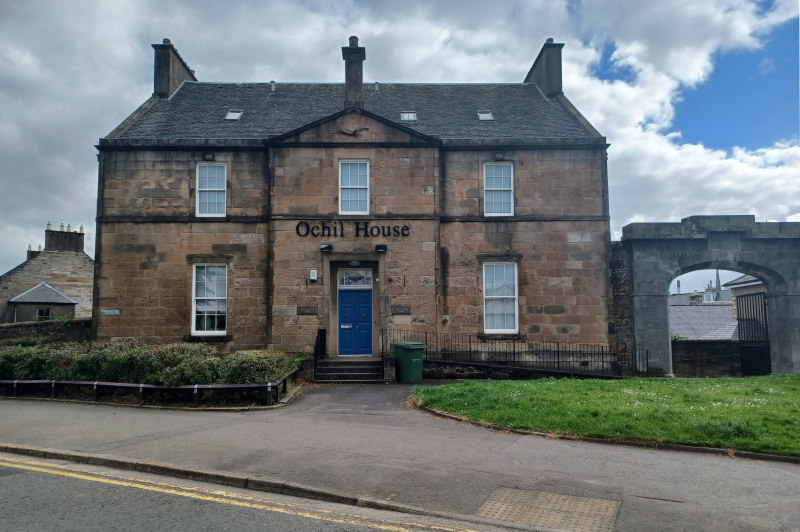Ochil House, once known as the Tontine Inn, Alloa, has enjoyed a long and ever-changing past - having been an Inn, a court and a police station at times before becoming what it is today.
The Tontine Inn name is unusual as comes from the method of funding of the building. At the time a group of subscribers would have invested in the venture, with the agreement that the last surviving of them would become the sole owner or sole dividend receiver. Investors could nominate a person, not necessarily themselves, whose continued existence triggered their dividend payments annually. On the death of the nominated person, the dividend payment would be pooled and split between the remaining subscribers.
The building now known as Ochil House was built in 1806 and opened for business as the Tontine Inn in 1807. It is designed in a simple classical style with an advanced central pediment and moulded doorcase. Although the building has had a variety of different uses over the years, the external appearance of the building remains largely unaltered. It is situated on a prominent site near the town hall on what was originally the main road between Fife and Stirling.
In 1807 a newspaper advertisement records that Malcolm Wright, who was probably the first proprietor of the Tontine Inn, 'begs leave to solicit the favour of the public' and that the inn is 'very commodious and well fitted up in every respect'. The date is confirmed by the fact that when the building was sold by public roup (auction) in 1829, it was stated that it was built 'upwards of twenty years ago'.
Early descriptions of the Tontine Inn show that the accommodation consisted of a spacious dining room and large travellers' room on the ground floor, a dining parlour on the first floor and seven bedrooms on the second floor with a kitchen and laundry and other service rooms in the basement. A separate stable block and other offices were located against the perimeter wall to the west while there was a bowling green and garden to the south.
In 1844 the building was converted into the county offices and gained further importance following the formation of Alloa Burgh in 1854, when the burgh constabulary was formed in March that year. In 1860 it became the courthouse with a series of nine prison cells in an extension to the west. The large dining room on the ground floor became the courtroom. When the new courthouse was erected nearby on Mar Street in 1863-65, the building continued to function as a prison with direct access to the court via a passage below Mar Street.
Less than 20 years later the old prison was closed.
In 1882, the building was again put up for sale and bought by Walter Erskine, Earl of Mar, and the prison cell block was demolished. The Alloa police headquarters remained in the old building in the basement for a time, while the upper floors were converted for the 1st Clackmannan and Kinross Volunteers. Around this time a large drill hall (later used by the Army Cadets) was erected at the southwest and the initials of this regiment appeared above the archway to the west of the building. The old stable block, situated against the north perimeter wall, remained into the 20th century.
In 1887 the burgh police force consisted of one Superintendent, two sergeants and five constables, all in charge of policing Alloa.
By 1914 the building was the drill station for 'B' Squadron of the Fife and Forfar Yeomanry and a base for 'E' and 'H' Companies, 7th Argyll & Sutherland Highlanders.
During the later 20th century, the building variously served as offices for the social work department in the 1970's, premises for small businesses. Ochil House was category B listed on 12th June 1972. After a major refurbishment in 1993, the building became the offices of Ochil View Housing Association, which is its current use.

Ochil House - May 2022
During the 1990's the drill hall in the grounds to the south was demolished and made way for a small social housing development. The Army Cadets moved to a new hall, the John Wynne Cadet Centre in Whins Road, where the Army Cadets and the Air Training Corps jointly operate.
A number of Tontine Inns were built in Scotland in the late 18th and early 19th century.
